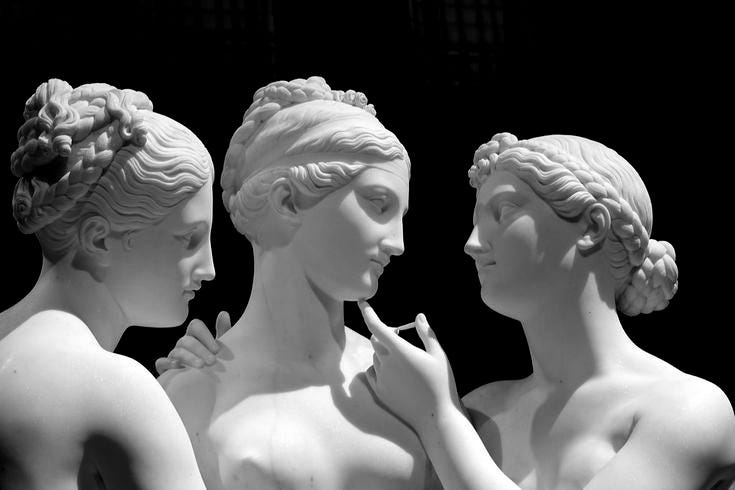Mastering the WhyChoose Romance
6 tips for writing fearless polyamorous love stories
First we had Challengers summer. Then, everyone was dissecting Molly Roden Winter’s memoir MORE: A MEMOIR OF AN OPEN MARRIAGE. Then, Barnes and Noble started spotlighting “whychoose” romance novels about heroines refusing to choose between their two (or five!) boyfriends.
Can you feel it in the air, like the humidity gathering before a summer thunderstorm? Polyamory is back in the cultural zeitgeist.
It’s disingenuous to call this conversation new, since people have been in open relationships since the dawn of time. People have been cheating on their partners since the dawn to time, too, but we’re not talking about that. We’re talking about overlapping intimate connections in which all parties have full knowledge of — and consent to — the other’s existence.
I hate getting didactic about art. I can often be found devil’s-advocating at parties about how art has no moral imperative except to be honest and make us feel something — if I have harshed the vibe at your cocktail night I am sorry. However, it’s undeniable that art also shapes and reshapes our perception of the world, and our presumptions about the people within it. So, with polyamory making a splash in society which, by and large, tends to choose monogamy and tends to regard polyamory as some sort of complex, sexy, ethically dubious mystery, how do we write with honesty in one hand and responsibility in the other?
Welcome to The Epistle, a newsletter about arts and culture, desire and spirituality, and the creative magic and hard numbers of making a living as an author. My name is Saint, and I’m so happy you’re here.
Getting to the Heart of the Constellation
Like any good love story, a love story built on non-monogamy is composed of multiplicities, of contradictions and fluidities and, of course, evolutions. There is no one model of nonmonogamy that all polyamorous people follow, and there are countless strategies and schools of thought around the practice. Peek into a poly forum and you’ll find discussion of everything from open marriages to nonhierarchical solo poly to swinging to kitchen table family systems to comet relationships. There’s lots of literature around the subject too (some of which I’ll link below in the ~syllabus~) but it all comes down to two key questions.
Why should love be hemmed in by the boundaries of binary? And, if a different way of loving is possible, how do we uncover that way together with authenticity, respect, and compassion?
While theory can enrich and inform a romance, labels do not a love affair make. So, in this essay we’re going to dive in to what I’ve discovered about writing a polyamorous romance that feels lived in, earned, grounded, and of course, seriously swoony.
Disclaimer: No one can possibly be an expert in love. I’m just a romantic who likes to think she remains open to love in all its forms, and who remains curious and empathetic in her attempts to meet her own needs and the needs of others. And, perhaps more relevantly, I’m a bestselling author of many novels which center complicated more-than-two love. We’ve got a bisexual sorcerer and his witch wife and the gay psychic in love with them both, troubled sapphics vying for their demanding lesbian poetry teacher’s attention, and a dysfunctional m/f/f/m vampire polycule in the mix. Never a dull day in the office.
Love Makes Sinners and Saints of Us All
Even though polyamorous romances can create delicious fictitious drama, it’s important to remember that polyamorous romances are no more inherently volatile or sensational than monogamous romances. And even though polyamorous stories can create tender moments of care and intimate connection, it’s important to remember that polyamorous romances are no more inherently wholesome and pure-of-heart than monogamous romances.
Anyone in love is all sinner all saint, all wounded animal and compassionate healer. We’re messy creatures trying to figure out how to treat other messy creatures well in a complex, sometimes merciful, often hostile environment. That’s the starting line for everyone. That’s the north star to re-align with when you feel your story pulling too melodramatic or too twee.
Choose Your Relationship Configuration
In a polyamorous romance, there are no rules regarding how many people can be involved with each other. Relationships can be romantic, sexual, platonic, professional, and fraternal, sometimes at the same time. It’s one of the most freeing things about writing this kind of love story, but it can also result in blank-page paralysis. If you can write any kind of love story, how do you know which one is right?
Keep reading with a 7-day free trial
Subscribe to Metaphysical Girl to keep reading this post and get 7 days of free access to the full post archives.




